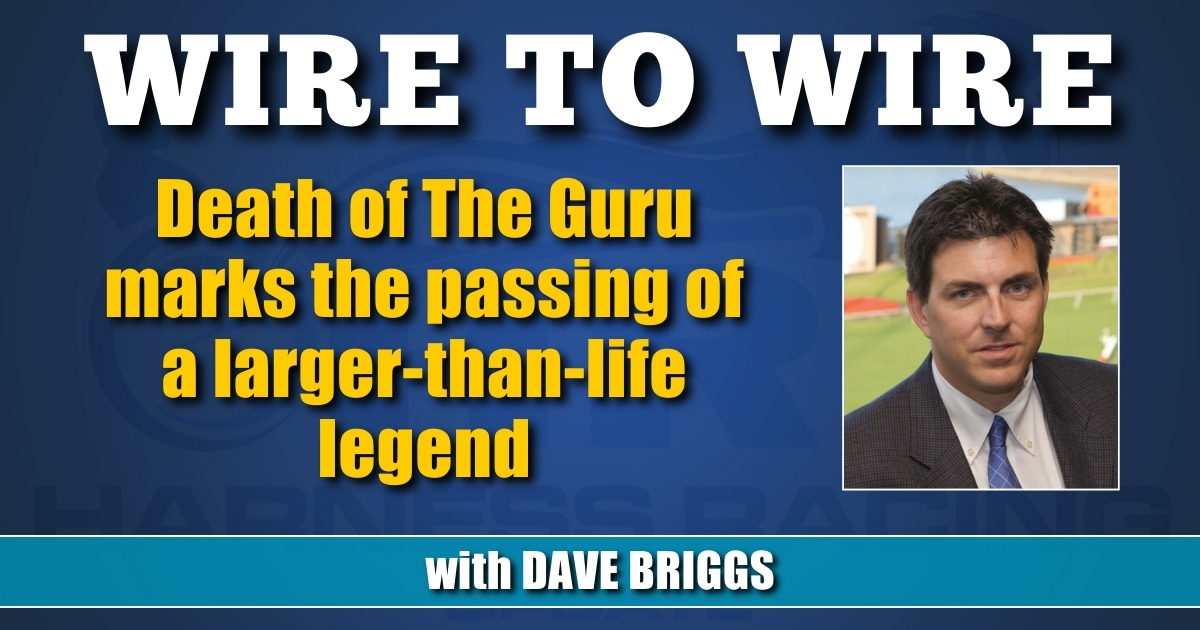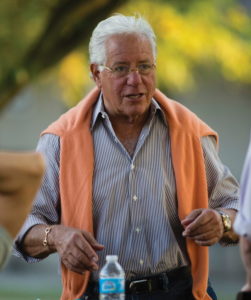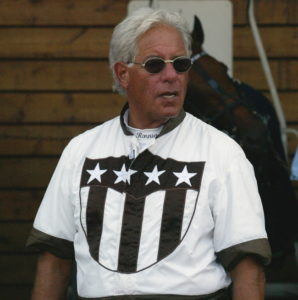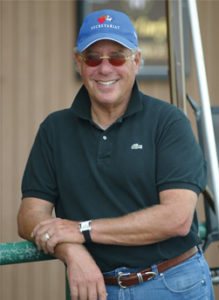Death of The Guru marks the passing of a larger-than-life legend
Hall of Fame trainer, HRU columnist and wholly original life force Ron Gurfein dead at 80.
by Dave Briggs
About five minutes after learning of the death of Ron Gurfein, Frank Sinatra’s My Way ominously came on the Internet radio station that was playing. For a station that predominantly plays rock music, it certainly felt like a message from the beyond from a man that was a true original.
Even in death, The Guru did things his way — and I’m not talking about sending me a song from harness racing Valhalla, though I’m not putting that past him.
When he mysteriously walked away from his popular HRU column Ask The Guru more than three months ago — after filing 165 consecutive weeks without fail (a complete archive of his columns is available here) — he did not give a reason. He sent a one line email on Jan. 21 saying he needed to take some time off and asked for privacy. I never heard from him again, despite sending him messages from time to time, including a final one 10 days before his death when I heard he likely didn’t have many days left.
Reportedly, few people in the industry — many very close friends — heard from him either. While I struggle to understand this, I have nothing but respect for how he chose to spend his final days before dying Wednesday (May 5) of brain cancer.
“If you’re only allowed one thing in life, that would be the thing to have the way you want it,” Art Zubrod, one of Gurfein’s closest friends, told me Thursday referring to being able to choose how you spend your final days.
“You know Ronnie and how vain he was. He didn’t like not being able to speak clearly. That was really, I believe, the first thing that led to his diagnosis was speech pattern… He wasn’t diagnosed until January. It went downhill fairly fast.”
Gurfein’s death was announced by his children, Lauren and Blake, via a simple message on The Guru’s Facebook page that said:
It is with profound sadness that we share that our dad, Ronnie Gurfein (a.k.a. “the Guru”), passed away earlier today. His was a long life filled with many joys, successes, and love. His wit was second to none and he had us laughing till his final moments.
Per his wishes, there will be a small family-only ceremony. We know he will be missed by many, so please stay tuned for information about a future celebration of his life and career.
In lieu of flowers or cards, we would appreciate donations in his name to Caring Across Generations – an organization dedicated to changing the way we care for older adults.
Please share memories and photos of Ronnie in the comments below.
With love and gratitude,
Lauren and Blake
A LIFE FORCE LIKE FEW OTHERS
Best known as a Hall of Fame trainer with three Hambletonian victories to his credit, Gurfein was a life force like few others; a giant in both accomplishment and ego that carved an indelible path through life.
While he could be utterly charming and confident and a complete rascal, in all honesty, he could also be an infuriating, never-wrong, pain in the butt.
What fewer people saw was that behind the sizeable bravado — and his love of great meals and status symbols — was a man of beauty and emotion and generosity that cared more than most will ever know.
“Everybody had a story about Ronnie, there’s no doubt about it. I’m not sure everybody knew what a nice man he was. He was generally a nice person and people didn’t get to see that side of him,” said Zubrod, emphasizing that he and Gurfein talked much more about life and family than horses.
“I remember several times, we’d be at the sale and he’d buy a horse for $50,000 and the guy next to him would say, ‘Ah man, I was wanting that horse, but I knew that I couldn’t outbid you’ and Ronnie would just hand him the ticket… you know, more than once. That’s the kind of guy he was.”
As for Gurfein’s brashness, Zubrod told me 22 years ago that he loved that side of Gurfein, “because it’s one thing that keeps his stable small.”
Zubrod chuckled Thursday when he was reread that quote.
As for Gurfein, he once said he could live no other way.
“I think just being as outgoing as I am, I’m such an easy target,” Gurfein said. “I wear my heart on my sleeve. I tell you the truth about everything. It’s great for your life. I sleep very well at night.”
SUCCESSFUL SECOND ACT
As for his column in HRU, Gurfein had the rare ability to allow his personality and perspective to take form through his words. His column was filled with passion, wonder and a deep knowledge of the game, particularly from the perspective of a trainer that tended to side with his fellow horsepeople. Ask The Guru was also a work of unshakeable opinions, conjecture, contradiction and, on occasion, BS.
Yet, above all else, it was must-read entertainment best consumed with a dose of salt.
Being his editor wasn’t easy at times. Like many readers, I didn’t always agree, but I tried my best not to tinker too much with his work lest I strip it of its originality. It was always his forum and I like to think he enjoyed having it, though he never said.
At the very least, Ask The Guru allowed one of our game’s most colorful personalities to have a successful second act to mutual benefit.
The column officially launched in November of 2017, but my personal relationship with Gurfein went back nearly 20 years before that.
I first met him in 1999 at the Meadowlands after he won his third and final Hambletonian with Self Possessed. He made an indelible impression if my feature in The Canadian Sportsman about that day is anything by which to judge:
He entered the room to a wave of applause, from reporters no less, and from the minute Ron Gurfein grabbed the microphone he was rolling.
“Come on, everybody clap,” he said with a sly grin and a wave of his arms, as if he had just been introduced for the first of three gigs in the Catskills.
For 20 minutes in the Meadowlands’ press box, The Guru of Trotting cracked jokes, told stories and even brought tears to his wife’s eyes by thanking her for her role in his life.
About the only thing missing was a little soft shoe and a rim shot…
This is, after all, a man whose first words to a reporter in the winner’s circle were: “Who is the most media-pro horseman that ever lived? Me.”
When it was all over, the silver-haired trainer departed the press box while he still had them eating out of his hand.
The only surprise was he exited stage left without shouting, “Thank you, Thank you” and encouraging his audience to try the quiche.
AUDIENCE WITH THE GURU
A few months later, I was on a plane to Florida to spend a few days with Gurfein at Sunshine Meadows for a more in-depth feature.
That experience led me to appreciate that Gurfein was much more than a successful horse trainer:
Today the Guru is speaking about empowerment. He points to a couple of motivational nuggets he has saved from one of those thought-for-the-day calendars.
“I have two things — ‘Everything is possible,’” he said, reading from the two slips of wisdom. “And, ‘Success is creative fullness. That is why the Latin word for genius also means spirit.’”
The words come from the mind of Deepak Chopra.
Ron Gurfein is something of a fan of such new age thinkers. He has the perfect place for a couple of motivational cassettes — inside his Lexus sport utility vehicle…
When people say Gurfein is cocky, he begs to differ.
“Cocky is a very bad word for it because I believe it’s my spirit that creates this. In other words, when I had Victory Dream and the media would say, ‘Do you think you’ll ever have a horse this good again?’ I would say, ‘Sure.’ They take that as cockiness. But that’s not cockiness, because I know myself,” Gurfein said, leaning back in his leather office chair and stroking the back of his head.
“Any person who is a student of all these things I believe in, will tell you that everybody has that power. We have not begun to tap into the resources of our own spirit. Mike Lachance always kids me because Wayne Dyer wrote a book called, ‘You’ll See It When You Believe it.’ (Lachance) knows that’s my theory.”
A LONG, STRANGE JOURNEY
Gurfein grew up in Manhattan and the journey from the big city to harness racing’s highest heights was a long, interesting one with many stops.
He was introduced to racing by his father, Sidney, a diamond importer.
“My father was a typical middle-class merchant. He bought single stones from Europe and sold them in America. He wasn’t a rich man,” Gurfein said.
On family vacations to Florida, Sidney would take Ron to see the thoroughbreds at Hialeah.
The family lived in an upper-middle-class neighborhood in Manhattan. During the summer, Gurfein and his friends would often hang out at Roosevelt and Yonkers.
Gurfein went to high school at the famed Bronx School of Science.
“It’s a school for intellectually-gifted kids. I was pretty intellectually gifted. I still think I am,” he said with a wink and a grin.
When Gurfein graduated, he enrolled at Emory University in Atlanta, GA. His goal was to become a pathologist.
“I wanted to be a doctor, didn’t really like the sight of blood and didn’t want to involve myself in that aspect of medical science, so I had two choices — to cure diseases, or to be a psychiatrist,” Gurfein said. “All the psychiatrists I knew were crazy. So I said, ‘I better not do this,’ because I was probably crazy to begin with.”
He stayed in school for two years then returned home to New York when his grandfather died.
“My grandfather manufactured fire hose in New Jersey. He died and there was no man (to run the business),” Gurfein said. “There was my mother and my grandmother… So, I left school and went to help my mother run a business that I knew nothing about. We fought like cat and dog every day. This went on for six or seven months and then I couldn’t take it.”
While on vacation in Florida, Gurfein struck up a conversation on the beach with a man who was president of a women’s clothing store named Paraphernalia. The company was looking to franchise its operation in New York. Six months later, Gurfein had opened three stores and business was booming. The year was 1965.
“It was avant garde stuff. Light up dresses. Mini dresses. Wild stuff. Wild sixties stuff,” Gurfein said.
Meanwhile, on the side, Gurfein bought into a few standardbreds.
Gurfein was only in the women’s clothing business for eight months before the company bought him out.
He took his new-found riches, invested almost all of it in the stock of the company which had purchased his grandfather’s fire hose company from his mother and then took off for a European vacation. In short order, the stock plummeted from $76 to $9 and when Gurfein returned to the United States he could not afford to pay his horse trainer.
So with time on his hands and not much money, Gurfein took up training himself. In 1967, he moved his operation to Monticello.
Dr. Paul Nolan, Gurfein’s long-time veterinarian, told me for that 1999 story that Gurfein’s earliest days in the horse business were spent learning all he could from his colleagues.
“He had the good sense to go to good people and knowledgeable people along the way,” Nolan said.
“I was the biggest pain in the butt on the racetrack,” Gurfein said. “You ask Jimmy Cruise, or Buddy Gilmour, or Frank Popfinger, people like that. They’ll tell you I was the biggest nuisance there ever was, because I would be asking questions until two o’clock in the afternoon trying to learn.
“I remember following Billy Haughton around watching him buy yearlings. I never told him I was following him. I just snuck around, watching what he looked for. I made mental notes myself on the horses and then saw the ones that he bought and the ones that he didn’t buy.”
MIGHTY M TO BIG M
Gurfein raced mostly at Monticello for the next 20 years.While he was away on vacation in 1987 with his family, his stalls at Monticello Raceway were given to another trainer.
It was the jolt he needed to point him toward the big leagues. Before that, thoughts of winning Hambletonians, training world champions and having million-dollar years never even occurred to him.
“I never had any desire. Couldn’t care less. I lived in Monticello. I was happy. I had my own life. I had my own circle of friends and everything like that.
“The most expensive horse I had in Monticello cost about $500. It’s a completely different kind of life. Monticello was like trying to bang out money. Buying horses, selling horses, racing. I didn’t race a lot of horses for a long period of time. I would go to sales, buy horses, bring them to the track, race them, sell them, go buy some more,” said Gurfein.
That all changed when Sonny Antonacci and his son, Frank, started giving Gurfein decent horses to train. Five years after moving to the Meadowlands out of necessity in 1987, Gurfein came up with the impressive trio of Imperfection, Baltic Striker, and Lady Starlet. He hit the pinnacle of the sport later that decade with horses such as Victory Dream and Beat The Wheel. Victory Dream started Gurfein’s long, successful relationship with Brittany Farms and an even longer one with Zubrod.
Gurfein won the Hambletonian three times in six years between 1994 (Victory Dream) and 1999 (Self Possessed) with perhaps his greatest pupil, Continentalvictory, winning the holy grail in between (1996). She also captured the Yonkers Trot en route to earning Horse of the Year honors that year.
He also trained such top horses as 2003 Trotter of the Year Cantab Hall and his first Hambletonian hopeful MB Felty, among other greats.
The Guru was named Trainer of the Year by the United States Harness Writers’ Association in 1999 and was inducted into harness racing’s Living Hall of Fame in 2006.
As for how Gurfein will be remembered, Zubrod isn’t sure.
“You think back on 20 or 30 years and you see how Stanley (Dancer) and (Billy) Haughton are remembered and then (Glen) Garnsey and (George) Sholty are remembered a little less so, so hopefully Ronnie will be fondly remembered by a lot of people 20 years from now.”
As for Zubrod, he will never forget his dear friend Ron Gurfein.
Bets are many others — myself included — won’t soon forget him either.
I’ve already had a sign from the other side that The Guru would never allow that.





















